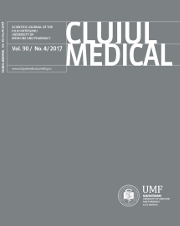Plasma protein absolute quantification by nano-LC Q-TOF UDMSE for clinical biomarker verification
DOI:
https://doi.org/10.15386/cjmed-880Keywords:
plasma, proteomics, absolute quantification, nano-LC Q-TOF UDMSeAbstract
Background and aims. Proteome-based biomarker studies are targeting proteins that could serve as diagnostic, prognosis, and prediction molecules. In the clinical routine, immunoassays are currently used for the absolute quantification of such biomarkers, with the major limitation that only one molecule can be targeted per assay. The aim of our study was to test a mass spectrometry based absolute quantification method for the verification of plasma protein sets which might serve as reliable biomarker panels for the clinical practice.
Methods. Six EDTA plasma samples were analyzed after tryptic digestion using a high throughput data independent acquisition nano-LC Q-TOF UDMSE proteomics approach. Synthetic Escherichia coli standard peptides were spiked in each sample for the absolute quantification. Data analysis was performed using ProgenesisQI v2.0 software (Waters Corporation).
Results. Our method ensured absolute quantification of 242 non redundant plasma proteins in a single run analysis. The dynamic range covered was 105.86% were represented by classical plasma proteins. The overall median coefficient of variation was 0.36, while a set of 63 proteins was found to be highly stable. Absolute protein concentrations strongly correlated with values reviewed in the literature.
Conclusions. Nano-LC Q-TOF UDMSE proteomic analysis can be used for a simple and rapid determination of absolute amounts of plasma proteins. A large number of plasma proteins could be analyzed, while a wide dynamic range was covered with low coefficient of variation at protein level. The method proved to be a reliable tool for the quantification of protein panel for biomarker verification in the clinical practice.
Downloads
Additional Files
Published
How to Cite
Issue
Section
License
The authors are required to transfer the copyright of the published paper to the journal. This is done by agreeing to sign the Copyright Assignment Form. Whenever the case, authors are also required to send permissions to reproduce material (such as illustrations) from the copyright holder.

The papers published in the journal are licensed under a Creative Commons Attribution-NonCommercial-NoDerivatives 4.0 International License.

